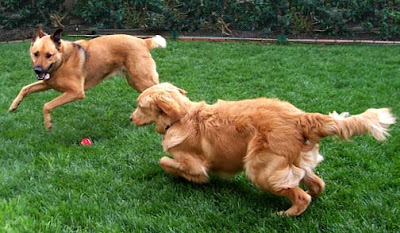Daily walks, jogs, or play sessions can pay huge dividends when it comes to your dog’s health. Not only will exercise help keep your dog fit and trim, regular activities can help channel your dog’s energy into a positive direction, like playing games or taking walks, rather than destructive ones like digging holes in the yard. Check out this guide to get tips on creating a safe and healthy canine workout plan.
Know the Benefits
Regular exercise can have a tremendous impact on your dog’s overall well-being. Dogs that get regular workouts enjoy a higher metabolism, smaller appetite, better muscle tone, and even better temperature regulation – a very important benefit for dogs in hot or humid climates.
In addition, exercise helps ward off canine obesity, a growing problem among our beloved pets, and helps prevent boredom as well. Behavioral issues often stem from a dog’s unmet instinctive desires to do things like dig, herd, retrieve, or hunt. By engaging your pup’s mind with positive activities, you’ll prevent him from finding destructive ways to satisfy his instincts, like digging or chewing inappropriately.
Consult Your Vet
Exercise needs can vary widely based on age, breed, and sex, as well as a dog’s individual health. If your dog is a 6- to 18-month adolescent or a sporting, herding, hound, or terrier breed or mixed breed, your dog’s exercise requirements are likely high. However, strenuous exercise can cause problems in some dogs, especially those that are not fit or are very young or old.
For this reason, it’s important that you talk with your vet before embarking on any new exercise routines with your dog. Athletic owners who run, jog, or perform other strenuous activities must be aware of their dog’s potential limitations. Also, be keenly aware of extreme weather conditions -- make sure to go easy on hot, humid, or cold days, and take plenty of breaks. If the dog is lagging behind, tiring, or struggling, head home and make the next exercise session slower (less strenuous) and shorter. Tip: Go slowly when introducing your dog to a new exercise routine, gradually building for the first weeks as he adapts. It’s always best to ask your veterinarian’s advice on how to safely increase your dog’s activity level.
Get Moving
There’s no shortage of ways to fulfill your dog’s exercise requirements, so try a number of activities to find which ones suit you and your dog’s needs. Here’s a list of the most common canine workout activities.
- Walking or jogging
- Fetch
- Running off leash (only where safe and appropriate)
- Swimming
- Playing with other pets
- Tricks for low-calorie treats (see below)
Make a Workout Plan
Since your dog can’t go to the gym, it’s up to you (and your vet) to devise a routine that will give him the proper exercise. For walks, work your way up to a brisk, 10 to 20 minute walk or jog twice a day. Sometimes introducing another dog is the key to encouraging more exercise activity. If you’re running short on time, hire a dog walker or schedule play-dates at a doggy daycare – both worthy investments. Regular visits with a friend or relative’s pet can also help your dog meet his exercise quota.
Consider Low-Calorie Treats
If tricks are your dog’s favorite pastime, low-calorie treats will encourage him to perform without negating his other calorie-burning activities. If your pet has any food allergies, consult your vet to determine which treats are safe and healthy for you dog.
- Apple slices
- Banana slices
- Carrot slices
- Low-calorie commercial treats
- Green beans
- Lean, cooked meat
- Melon chunks
- Pear slices
- Popcorn (without butter or oil)
- Rice cake pieces
Your dog’s exercise needs will change over time so make sure to continue speaking with your veterinarian about what is best for your dog.
All information from VetStreet.












0 comments:
Post a Comment